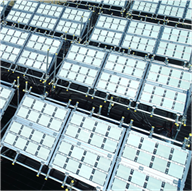报告题目:Photocatalytic solar hydrogen production for a large-scale application
报告时间:2021年11月11日(星期四)上午10:00-11:30
报告地点:腾讯会议
会议ID: 899 726 027
报 告 人:Prof. Kazunari Domen(教授、信洲大学&东京大学)
报告摘要:

Fig. 1. A 100 m2 scale photocatalytic solar hydrogen production system.
Overall water splitting using particulate photocatalysts has been att racting attention as a means of large-scale renewable solar hydrogen production [1]. The author’s group has studied various semiconductor oxides, (oxy)nitrides, and (oxy)chalcogenides as photocatalysts. The apparent quantum yield of overall water splitting using the SrTiO3 photocatalyst has been improved to 95% in the near-ultraviolet region by refining the photocatalyst and cocatalyst preparation [2]. This quantum efficiency is the highest ever reported, indicating that particulate photocatalysts can drive the uphill overall water splitting reaction as efficiently as the photon-to-chemical conversion process in photosynthesis. In addition, the author's group has also been developing panel reactors for large-scale applications. A solar hydrogen production system with a light-receiving area of 100 m2 was built (Fig. 1), and its performance and system characteristics including safety issues was reported recently [3].
For practical solar energy harvesting, it is essential to develop photocatalysts that are active under visible light irradiation. Ta3N5 and Y2Ti2O5S2 photocatalysts are active in overall water splitting via one-step excitation under visible light irradiation [4,5]. Particulate photocatalyst sheets efficiently split water into hydrogen and oxygen via two-step excitation, referred to as Z-scheme, regardless of size. In particular, a photocatalyst sheet consisting of La- and Rh-codoped SrTiO3 and Mo-doped BiVO4 splits water into hydrogen and oxygen via the Z-scheme, showing a solar-to-hydrogen energy conversion efficiency exceeding 1.0% [6,7]. Some other (oxy)chalcogenides and (oxy)nitrides with long absorption edge wavelengths can also be applied to Z-schematic photocatalyst sheets.
In my talk, the latest progress in the development of photocatalytic materials and their reaction systems will be presented.
References
[1] Hisatomi et al., Nat. Catal. 2019, 2, 387.
[2] Takata et al., Nature 2020, 581, 411.
[3] Nishiyama et al., Nature 2021, 598, 304.
[4] Wang et al., Nat. Catal. 2018, 1, 756.
[5] Wang et al., Nat. Mater. 2019, 18, 827.
[6] Wang et al., Nat. Mater. 2016, 15, 611.
[7] Wang et al., J. Am. Chem. Soc. 2017, 139, 1675.

报告人简介:
Prof. Kazunari Domen(堂免一成先生),分别于1976年、1979年、1982年在东京大学科学学院获得学士、硕士、博士学位。1982-2004年在东京工业大学从事助理研究员、副教授和教授, 2004年至今任东京大学工学院化学工程系教授,2017年起在日本信州大学能源与环境科学中心担任特聘教授。获得的荣誉奖项有:2007年获日本催化协会奖,2011年获日本化学会奖。研究兴趣有:光催化分解水研究、基于红外光谱的多相催化研究、基于非线性激光光谱的表面动力学反应研究,以及新型功能化催化材料的开发。